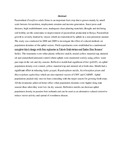Utilization Of Cultural Methods For Controlling Aphid Vectors Of Passion fruit Viruses

View/
Date
2011Author
Kilalo, D.C
Olubayo, F.M.
Ateka, E.M
Hutchinson, M.J
Kimenju, J.W
Type
PresentationLanguage
enMetadata
Show full item recordAbstract
Passionfruit (Passiflora edulis Sims) is an important fruit crop that is grown mainly by small
scale farmers for nutrition, employment creation and income generation. Insect pests and
diseases, high establishment costs, inadequate clean planting materials, drought and declining
soil fertility are the constraints to improvement of passionfruit production in Kenya. Passionfruit
growth is severely limited by viruses which are transmitted by aphids in a non-persistent manner.
The study was conducted in 2008 and 2009 to investigate the effect of cultural methods on
population densities of the aphid vectors. Field experiments were established in a randomized
complete block design with four replicates in Kabete field station and Embu (four farmers’
fields). The treatments were white plastic reflective mulch, treated yellow material trap, mineral
oil and unmulched/untreated control where aphids were monitored weekly using yellow water
pan traps in the wet and dry seasons. Reflective mulch had significant effect (p<0.05). on aphid
population density over control, yellow material trap and mineral oil at both sites. Mulch had a
significant effect in reducing Aphis gosypii, Ropalosiphum maidis, Acyrthosiphon pisum and
Macrosiphum euphorbiae which are also reported vectors of CMV and CABMV. Aphid
populations peaked only once in June coinciding with the major season for growing food crops.
All the treatments achieved better effect when population densities were higher (long rain
season) than when they were low (in dry season). Reflective mulch can decrease aphid
population density in passion fruit orchards and can be used as an alternative cultural control to
reduce vector activity and spread of woodiness disease.
